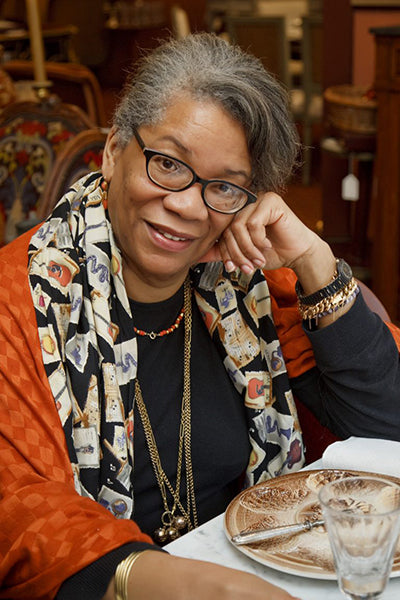🎄 We are open 7 days a week, 10am - 6pm 🎄
By Jessica B. Harris
Pralines are a major part of culinary New Orleans. Where did they come from and How did they get here are another fascinating tale of the city. Let’s begin with the no doubt apocryphal tale of the origin of the candy that became synonymous with the Crescent City. We are told that the cook. of the Duke of Plessis-Praslin (1589-1675) invented a method for coating whole almonds in grained caramelized sugar, and eventually began to produce the sweets that became increasingly popular commercially. By the 18th century, this form of the candy was well known and is even recorded in cookbooks as a “prawlin”. This meaning of the word praline is still used in chocolate making and refers to a candy that is prepared from crushed nuts and sugar. The nuts used are usually almonds, but they may also be hazelnuts or other nuts.
From Europe the term, if not the form, moves into New World and the Caribbean sugar islands where confections prepared from sugar syrups or molasses with the addition of local nuts are commonly sold on streets by vendors who were often free people of color selling to make additional income or enslaved folk working for their mistresses. The New World candies are found under varying different names like tablette de coco (coconut confections) in Martinique and Guadeloupe, pinda cakes (peanut patties) in Jamaica, and pe de moleque (young boy’s foot!) in Brazil. These candies commonly (but not exclusively) use local nuts: Brazil nuts, peanuts, and so forth.
According to John Mariani’s, 1999 Encyclopedia of American Food and Drink, in North America, pralines and their culinary cousins are a specialty of several southern states. In Louisiana, especially New Orleans, the name praline applies to candies made with pecans in a coating of brown sugar which was sold by Creole women known as pralinières. Even before the Civil War and Emancipation, pralines were an early entrepreneurial vehicle for free women of color in New Orleans. The confection is first mentioned in print in 1715, and part of Louisiana food culture as early as 1762.
In 1901, the Daily Picayune an early city newspaper reminded people that the pralinières or older black women who sold pralines about the streets of the French Quarter were often found on Canal Street near Bourbon and Royal streets and around Jackson Square in the areas flanking St. Louis Cathedral. In the 1930s, the Louisiana folklorist Lyle Saxon, writing in the book Gumbo Ya-Ya, documented praline sellers, "garbed in gingham and starched white aprons and tignons, or head wraps, fanning their candies with palmetto leaves against the heat and bellowing the sales pitch ‘belles pralines!’ to passersby.”
Street vendors selling pralines are difficult to find nowadays, but the popular candy that is a much-loved souvenir of the city is available in multiple versions in shops around the French Quarter. Innovations have led to crisp ones that are more like the classic praline as well as creamier versions and even chewy versions. The late doyenne of New Orleans Creole cooking, Leah Chase, recalled that in her youth pralines were also pink and white and prepared from coconut as well as with pecans which would place them even more firmly in the arc of New World Caribbean confectionary.
Pralines are still used by many African American women and young girls as a way to gain additional income and they can often be found alongside vegetables and fruits that are for available sale from car trunks and trucks in local neighborhoods. They are often sold not only under the name of praline, but often simply as pecan candy. The candy's winning flavor spawned multiple recipes each with its partisans. As for the pronunciation of the word praline and the pecan nut that goes into the classic ones, the local New Orleans pronunciation is "prah-lean," while the nut most commonly used in it is pronounced "pec-cahn." (Mispronunce them to a local if you want to hear a rude joke about a pea-can.). However you pronounce them and wherever you find them, they have become a symbol of the city and are an edible reminder of it's vibrant culinary history.
All three images above are from the Louisiana Digital Database
Praline Woman - Louisiana State Museum Newcomb College Arts and Crafts
Jackson Square - LSU Libraries - Charles L. Thompson Photographs
Praline Lady Study - Ogden Museum of Southern Art
Jessica B. Harris (born March 18, 1948) is an American culinary historian, college professor, cookbook author and journalist. She is professor emerita at Queens College, City University of New York, where she taught for 50 years, and is also the author of 15 books, including cookbooks, non-fiction food writing and memoir. She has twice won James Beard Foundation Awards, including for Lifetime Achievement in 2020, and her book High on the Hog was adapted in 2021 as a four-part Netflix series by the same name.
Harris is professor emerita in the English Department at Queens College/C.U.N.Y, where she taught for 50 years. She was the inaugural scholar in residence in the Ray Charles Chair in African American Material Culture at Dillard University in New Orleans. She also founded the Institute for the Study of Culinary Cultures at Dillard. She hosts a monthly program, My Welcome Table, on Heritage Radio Network. She has published 12 books. Her primary subjects are the culinary history, foodways and recipes of the African diaspora. Harris was a 2004 winner of the lifetime achievement awards from the Southern Foodways Alliance and a 2010 James Beard Foundation special award honoree. In 2017 she published a memoir My Soul Looks Back.
